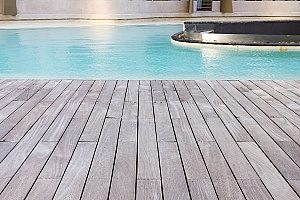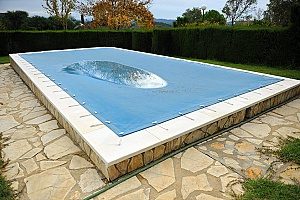 Many homeowners enjoy having a pool in their backyards — at least, they do for a few years. Eventually, some begin to wonder whether having the pool is really quite as nice as it was at the beginning. Rather than continue to spend time, money, and energy dealing with a pool, an increasing number of homeowners choose to undergo a pool removal, allowing them to reclaim their backyards and stop spending time, money, and stress on an unused pool. For many, the initial investment of removing the pool is worth the new space they discover in their yard, which can be used for everything from gardening to remodeling. Here’s what you should know before hiring a pool demolition contractor to assist with your pool removal.
Many homeowners enjoy having a pool in their backyards — at least, they do for a few years. Eventually, some begin to wonder whether having the pool is really quite as nice as it was at the beginning. Rather than continue to spend time, money, and energy dealing with a pool, an increasing number of homeowners choose to undergo a pool removal, allowing them to reclaim their backyards and stop spending time, money, and stress on an unused pool. For many, the initial investment of removing the pool is worth the new space they discover in their yard, which can be used for everything from gardening to remodeling. Here’s what you should know before hiring a pool demolition contractor to assist with your pool removal.
What Happens During a Pool Removal?
Homeowners have two choices when it comes to removing their pools: partial and full removals. In a partial pool removal, only the top 18 inches of the pool are demolished. The debris is left in the bottom of the pool to be used as fill, and the remaining space is filled in with dirt. The filling is then compacted and covered in grass. Partial pool removals are the cheaper and faster option, but homeowners are limited on what they can do with the new space. They may install new features like gardens, sheds, and patios, but they cannot build a new living area on the space.
In a full pool removal, the entire pool shell is demolished and all of the resulting debris is removed. The cavity is filled with fill dirt before being compacted and covered in grass. Full pool removals can take up to seven days and are more expensive than partial pool removals. However, they allow homeowners to use the new land for any purpose, including building new living areas, such as an extension to your home or a small apartment. Contractors generally prefer this type of pool removal as well, as they typically have a smaller margin of error.
The type of pool removal you choose will depend on your time, budget, and intended use of the land remaining after the pool is filled in. A professional pool demolition contractor can help homeowners determine which type of removal is best for each individual situation before the pool removal is completed.
Winter Pool Maintenance
 Even when no one is using the pool, it will have to be maintained during the winter months to ensure that it does not get damaged. The average pool owner can expect to spend up to $3,200 on repairs, electricity, and water for their pools. Additional maintenance can bring that cost up to $5,000 per year. Maintaining a pool — including cleaning, inspecting equipment, making repairs, and completing chemical maintenance — can take up to an hour each week. Over the winter, daily maintenance tasks can include removing frost or snow from pool covers to prevent damage and continued equipment and chemical checks. This prevents the water from becoming contaminated by algae and other issues, which could require the water to be drained for intensive cleaning if the problem is allowed to grow.. For many homeowners, these financial and scheduling demands are simply too much, especially during the winter when other home maintenance tasks may take precedence.
Even when no one is using the pool, it will have to be maintained during the winter months to ensure that it does not get damaged. The average pool owner can expect to spend up to $3,200 on repairs, electricity, and water for their pools. Additional maintenance can bring that cost up to $5,000 per year. Maintaining a pool — including cleaning, inspecting equipment, making repairs, and completing chemical maintenance — can take up to an hour each week. Over the winter, daily maintenance tasks can include removing frost or snow from pool covers to prevent damage and continued equipment and chemical checks. This prevents the water from becoming contaminated by algae and other issues, which could require the water to be drained for intensive cleaning if the problem is allowed to grow.. For many homeowners, these financial and scheduling demands are simply too much, especially during the winter when other home maintenance tasks may take precedence.
Planting Ahead
Fall is the perfect time to begin considering the layout of new lawns and gardens. In the Northern Virginia and Maryland areas, mid-August to late October are the best times to seed a lawn. This provides seeds with the proper temperature for germination, more rain to nourish the seeds, and less competition from weeds that may grow nearby. Removing a pool in the fall gives homeowners plenty of time to begin the planning, planting, and care necessary to have a beautiful, lush lawn to enjoy during the spring and summer months. The lawn can be used for entertaining and playing with far less risk than a pool presents, making removal a compelling choice for families with small children.
Safety First
Having a pool comes with an elevated risk of injury and even death. According to the U.S. Consumer Product Safety Commission, an average of 5,000 people received emergency medical care for injuries sustained as a result of pools or hot tubs each year in 2011, 2012, and 2013. The risk of injury is even greater for small children, as drowning is the leading cause of unintentional death for children between age 1 and age 4, according to the Centers for Disease Control, which also reported that about half of swimming-related injuries among children happened in residential pools. Pets who are not strong swimmers may also be at risk of drowning or injury. These risks require constant vigilance and the installation of a strong, child-proof fence around the pool, and many homeowners may prefer to remove the pool altogether rather than spend the stress and money required to ensure safety around the pool.
Insurance Savings
 Due to these increased liabilities, homeowners with a pool are often advised to increase their liability coverage from $100,000 to $500,000. This can increase yearly premiums by up to $75 per year. While this may not seem like a significant amount of money, the costs can add up over time, and many homeowners are resentful of spending more money than necessary on their unused pools. Removing the pool alleviates the potential strain on the wallet and provides peace of mind that the backyard is safe.
Due to these increased liabilities, homeowners with a pool are often advised to increase their liability coverage from $100,000 to $500,000. This can increase yearly premiums by up to $75 per year. While this may not seem like a significant amount of money, the costs can add up over time, and many homeowners are resentful of spending more money than necessary on their unused pools. Removing the pool alleviates the potential strain on the wallet and provides peace of mind that the backyard is safe.
Employing a Pool Demolition Contractor
Speak to a professional pool demolition contractor for more information and to schedule your pool removal service. Dirt Connections has been providing pool removal services to homeowners within the Northern Virginia area for years. The firm completes both partial and full removals and provides free estimates and consultations to help people determine the best type of removal for their needs. Dirt Connections prides itself on completing its projects as quickly and affordably as possible, with minimal mess and disruption to its clients’ lives. The firm serves clients in Northern Virginia and Maryland.









































